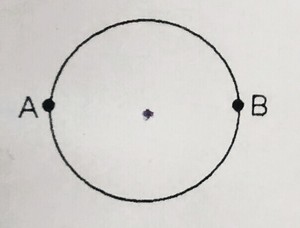Circular Resistance?
A wire of resistance is bent to form a complete circle of radius as shown in the figure. What is the resistance between its two diametrically opposite points and ?

This section requires Javascript.
You are seeing this because something didn't load right. We suggest you, (a) try
refreshing the page, (b) enabling javascript if it is disabled on your browser and,
finally, (c)
loading the
non-javascript version of this page
. We're sorry about the hassle.
The total resistance of the ring is R = ( 1 2 Ω / m ) × 2 π ( 0 . 1 m ) = 2 . 4 π Ω .
When the resistance is measured diametrically, it is equivalent to having the total resistance cut into two equal resistors with resistance equal to R / 2 but placed in parallel. Thus, the parallel resistance is equivalent to ( R / 2 1 + R / 2 1 ) − 1 = R / 4 = 0 . 6 π Ω .